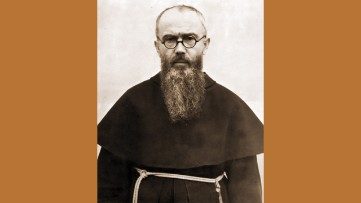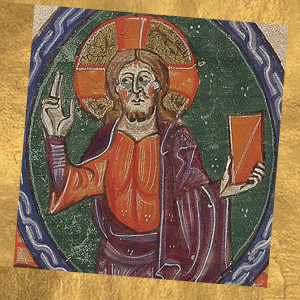St. Maximilian M. Kolbe, priest of the Order of the Friars Minor Conventual and Martyr

The two crowns
Born in 1894 in Zduńska Wola, in what is now Poland, Raimund Kolbe was an easygoing, ordinary boy. As any boy, he occasionally earned scoldings from his mother. “Son, what will become of you?”, she exclaimed when he was twelve. His mother noted that after that particular scolding, her son’s behavior changed. Worried that he might be sick, she asked what was wrong. Trembling, he told her, “I prayed very hard to Our Lady to tell me what would become of me…. Then the Virgin Mother appeared to me holding in her hands two crowns, one white and one red. She looked at me with love and asked me if I would like to have them. The white meant that I would remain pure and the red that I would be a martyr.”
Not long afterward, the 13-year-old Raimund entered the Conventual Franciscans’ minor seminary. In 1910, he entered the novitiate as Brother Maximilian and was soon sent to study in Rome. While there, he and some friends founded the Militia Immaculatae [the Army of the Immaculate] to promote total consecration to the Mother who had looked at him with love.
Two “cities of Mary”
Ordained in 1918, the new priest returned to Poland, founding a monthly magazine and a printing press to further devotion to the Mother of God. He contracted tuberculosis, which compelled him to rest for a time, but it did not stop his zeal. By 1927, his publishing apostolate had grown so much that Father Maximilian founded a new friary, Niepokalanow, the “city of Mary,” outside Warsaw. The “city” wasn’t his but hers, he insisted, and to make that point clear, he soon asked his astonished superior if he could leave it in her hands and go on mission. Where? Japan. How will you live? “The Blessed Mother has her plan ready.”
That was the beginning of a new “city of Mary,” Mugenzai no Sono, founded in 1931 on a hillside near Nagasaki. People told Father Maximilian that the spot was not good for building, that it had a bad view, but he insisted. When the atomic bomb was dropped on Nagasaki 14 years later, destroying the city, the friary, protected by the hills that gave it a bad view, remained standing and was able to help hundreds of the injured.
War
Re-elected superior of Niepokalanow, Father Maximilian returned to Poland in 1936. He took up his old work with the publications, as Germany began its plans for the conquest of Europe. In 1939, Germany invaded Poland. The friary took in refugees, including many Jews, but by 1941 the invaders could no longer stand such a beacon of faith and humanity. Father Maximilian and four other friars were arrested. In May, he became prisoner 16670 at the Auschwitz concentration camp. Other prisoners remembered him, frail but full of peace, hearing confessions and comforting others under the cover of night. “Hate is not creative,” he whispered to those who came to him in despair, “only love is creative.”
Martyr of charity
Hate destroys. So when a prisoner escaped in late July 1941, the German commandant decided that, as punishment, ten of the escapee’s fellow prisoners would be chosen for the privilege of death by starvation. He walked up and down the lines of prisoners, choosing. “You!”, he said, pointing to Franciszek Gajowniczek, who burst into tears and cried out, “My wife and children!”
And love is creative. So out of the ranks of prisoners, a man stepped forth. The other prisoners gaped in astonishment. “Take me instead. I have no wife or children.” “Who are you?” “A Catholic priest.” The commandant was so taken aback that he agreed. For two weeks, Father Maximilian consoled the men sealed with him into the starvation bunker. Cells like that, prisoners noted, were usually places of horrible, screaming delirium. But from there they heard men singing, praying, until finally, that priest was the only one still alive. The guards came in with a syringe filled with carbolic acid. The priest, weak but lucid, held out his arm, and on August 14, 1941, Maximilian Kolbe received his two crowns.







